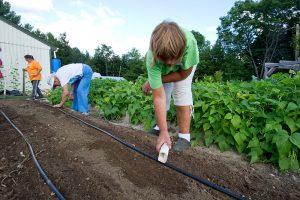Bulletin #4311, Planning and Managing a Community “Giving” Garden in Maine (Sections 21-22)
Repeat Plantings
You have moved a small mountain getting all your beds planted. By this point, you are probably well into the month of June. You are busy thinning a lot of plants, weeding a lot of beds, and feeding on a regular basis. The first plants you will harvest will be spinach, lettuce, Swiss chard, and baby kale.
Knowing which crops do well with multiple plantings is useful. Spinach should not be replanted in June or July, as it will bolt. Spinach can be replanted in early August for a fall harvest if your recipients like spinach. I have tried to do multiple spread-out plantings of lettuce. I think if you separate the plantings by 2 weeks, and then 3 weeks, you can get at least three good harvests of lettuce. If you can start with two sets of transplants and then move to two sowings of seed lettuce, I think this is a good plan. Eventually if it is a typical hot summer, lettuce will tend to bolt and become bitter. Once lettuce starts to form a cone, it is likely becoming too bitter to harvest and give away.
Swiss chard and beets can be replanted regularly. Swiss chard will allow a harvest and regrow, as was previously discussed. If you want small leaves for a salad, you can always replant Swiss chard until about mid-July.
Carrots can be planted again up until early July. The issue with planting carrots in late June or early July will be moisture and germination. Because it is hotter than earlier in the year, it may be more difficult to get good germination.
As you can see from Table 2, most of our cabbages are given out in mid- to late-July and early August. If you would like to have cabbages to deliver in September, you would need to do a second round of planting. Our issue is that most of the sources where we buy transplants close after Memorial Day. So, if you want to do your own plant starts in a green house and transplant them, you can. We don’t have that capacity.
Beets, kale, and lettuce can be replanted in mid-July up to the end of July. The difficulty is making sure the seeds stay sufficiently moist to germinate.
Cover Cropping
It is always better to have something growing in a bed than to leave it empty. The growing plants exude nutrients and food for microorganisms. The growing plants shade out weeds. So, it is helpful to plant a cover crop. Any growing plant can be a cover crop, but the best ones to plant will fit your goals. It is advisable to plant a cover crop that will winter kill so that it won’t get ahead of you in the spring. Winter rye is an excellent cover crop for farmers who can kill it with an herbicide prior to working the soil. They get biomass in the spring. But, if you are organic and must kill it, it is a lot of work. Crops like oats, peas, and crimson clover will winter kill, and all you must do is turn the soil in the spring. They will break down prior to vegetable planting.
Learn more about cover crops: seeding rates, reasons for use, when to sow, and when and how to incorporate into the soil.
In complying with the letter and spirit of applicable laws and pursuing its own goals of diversity, the University of Maine System does not discriminate on the grounds of race, color, religion, sex, sexual orientation, transgender status, gender, gender identity or expression, ethnicity, national origin, citizenship status, familial status, ancestry, age, disability physical or mental, genetic information, or veterans or military status in employment, education, and all other programs and activities. The University provides reasonable accommodations to qualified individuals with disabilities upon request. The following person has been designated to handle inquiries regarding non-discrimination policies: Director of Equal Opportunity and Title IX Services, 5713 Chadbourne Hall, Room 412, University of Maine, Orono, ME 04469-5713, 207.581.1226, TTY 711 (Maine Relay System).


